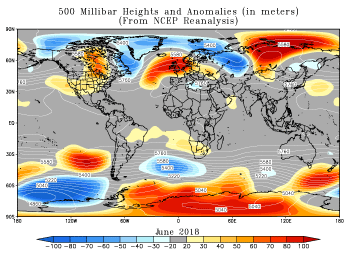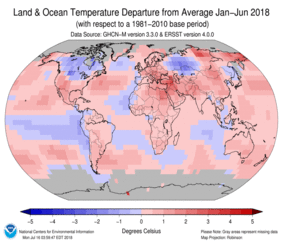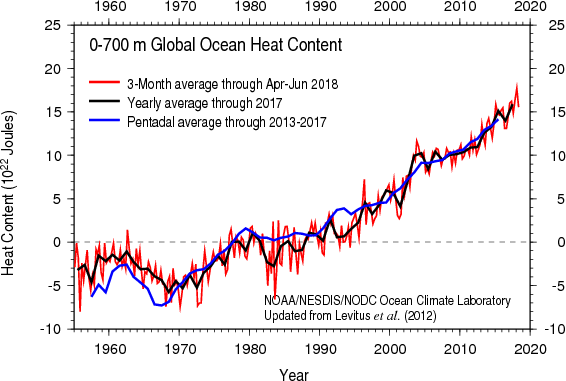Introduction
Temperature anomalies and percentiles are shown on the gridded maps below. The anomaly map on the left is a product of a merged land surface temperature (Global Historical Climatology Network, GHCN) and sea surface temperature (ERSST.v4) anomaly analysis as described in Huang et al. (2016). Temperature anomalies for land and ocean are analyzed separately and then merged to form the global analysis. For more information, please visit NCEI's Global Surface Temperature Anomalies page. The percentile map on the right provides additional information by placing the temperature anomaly observed for a specific place and time period into historical perspective, showing how the most current month, season or year compares with the past.
Temperatures
In the atmosphere, 500-millibar height pressure anomalies correlate well with temperatures at the Earth's surface. The average position of the upper-level ridges of high pressure and troughs of low pressure—depicted by positive and negative 500-millibar height anomalies on the  June 2018 map—is generally reflected by areas of positive and negative temperature anomalies, respectively, at the surface.
June 2018 map—is generally reflected by areas of positive and negative temperature anomalies, respectively, at the surface.
June
June 2018 was characterized by warmer-than-average conditions across much of the land and ocean surfaces, with the most notable warm temperature departures from average across central Asia where temperatures were 4.0°C (7.2°F) above average or higher. Record warm June temperatures were present across parts of central Asia as well as portions of the Atlantic, Pacific, and Indian Oceans, and Mediterranean Sea. Cooler-than-average June temperatures were observed across eastern Canada, Greenland, western and eastern Russia, and across portions of the Atlantic and Pacific oceans. The only area with record cold June temperatures was the northern Atlantic Ocean, off Greenland's southern coast.
The globally-averaged temperature across land and ocean surfaces was the fifth highest on record for June at 0.75°C (1.35°F) above the 20th century average of 15.5°C (59.9°F). The ten warmest Junes on record have occurred since 2005, with 2016 the warmest June at +0.91°C (+1.64°F). June 2018 also marks the 42nd consecutive June and the 402nd consecutive month with temperatures, at least nominally, above the 20th century average.
According to NCEI's Regional Analysis, four of six continents had a June temperature that ranked among the seven warmest June since continental records began in 1910. Europe had its second warmest June on record, behind 2003. Meanwhile, South America had its smallest June temperature departure from average since 2008.
The global land-only June temperature was 1.06°C (1.91°F) above the 20th century average and ranked as the sixth highest June temperature on record. The global ocean-only June temperature was also the sixth highest at 0.62°C (1.12°F) above average.
Select national information is highlighted below. Please note that different countries report anomalies with respect to different base periods. The information provided here is based directly upon these data:
- Oman observed its highest minimum (nighttime) temperature on record when temperatures dropped to only 42.6°C (108.7°F) in Quriyat on June 26. This appears to be a new Asian record and, according to some media sources, a world record warm minimum temperature. However, according to NCEI's Global Historical Climatology Network - Daily, a higher minimum temperature of 43.3°C (110°F) occurred in Furnace Creek (formerly known as Greenland Ranch) located in California's (United States) Death Valley National Park on 5 July 1918. Potential world and continental-scale temperature and other climate records are evaluated by the World Meteorological Organization.
- Austria's June 2018 national temperature was 1.9°C (3.4°F) above average and was one of the ten warmest Junes on record. Austria's national records extend back to 1767.
- Denmark had its warmest June since 1992 and tied with 1947 and 1953 as the sixth warmest since national records began in 1874 at 16.5°C (61.7°F) or 2.2°C (4.0°F) above average. The highest June temperature for Denmark was set in 1889 at 18.2°C (64.8°F). The national maximum and minimum temperature for the month ranked as the third and seventh highest, respectively, since records for maximum and minimum temperatures began in 1953.
- Warmer-than-average conditions engulfed much of the United Kingdom, giving way to the third warmest June since national records began in 1910 at 1.8°C (3.2°F) above the 1981–2010 average. Provisionally, England had its fourth highest June temperature also at 1.8°C (3.2°F) above average; Wales had its warmest June on record at +2.2°C (+4.0°F); June 2018 tied as the third warmest June on record for Scotland at +1.7°C (+3.1°F); and Northern Ireland had its warmest June on record at 2.1°C (3.8°F) above average.
- The last few days of June 2018 were exceptionally warm across the British Isles, with several days recording maximum (daytime) temperatures above 25.0°C (77°F). The station in Shannon, Ireland, had a maximum temperature of 32.0°C (89.6°F) on June 27, an absolute record for this location. Ireland hasn't experienced June temperatures this hot since 1976. The last time maximum temperatures were 32.0°C (89.6°F) or higher was in July 2006.
- Glasgow, Scotland also experienced unusually high temperatures at the end of the month, with the most notable temperature set on June 28 when temperatures soared to 31.9°C (89.4°F)—a new all-time record for the city. This value was 1.0°C (1.8°F) lower than Scotland's maximum temperature record set on 9 August 2003 at Greycrook. There were reports that the high temperatures in Glasgow were causing the roof of the Glasgow Science Center to partially melt.
- Maximum temperatures soared to 30.5°C (86.9°F) on June 27 in Enniskillen in Northern Ireland, which is only 0.3°C (0.5°F) shy of tying the territorial absolute record of 30.8°C (87.4°F) set in June 1976 and again in July 1983.
- France had its fifth highest June temperature since national records began in 1900 at 1.7°C (3.1°F) above average. France also had the second highest April–June period on record at 1.9°C (3.4°F) above the 1981–2010 average. This value is only 0.1°C (0.2°F) below the record set in 2003.
- The national June 2018 temperature for the Netherlands was 17.5°C (63.5°F), which is 1.9°C (3.4°F) above average and was the sixth highest June temperature on record.
- Switzerland had its fourth warmest June since national records began in 1864 at 2.0°C (3.4°F) above the 1981–2010 average.
- South Korea had its second warmest June maximum temperature on record. Several locations set new maximum June temperature records as temperatures were above 35.0°C (95.0°F).
ENSO-neutral conditions persisted across the tropical Pacific Ocean during June 2018. According to NOAA's Climate Prediction Center, ENSO-neutral is favored through the Northern Hemisphere summer (Southern Hemisphere winter), with the chance for El Niño increasing to about 65% during September–November 2018. This forecast focuses on the ocean surface temperatures between 5°N and 5°S latitude and 170°W to 120°W longitude, called the Niño 3.4 region.
| June | Anomaly | Rank (out of 139 years) | Records | ||||
|---|---|---|---|---|---|---|---|
| °C | °F | Year(s) | °C | °F | |||
| Global | |||||||
| Land | +1.06 ± 0.12 | +1.91 ± 0.22 | Warmest | 6th | 2015 | +1.26 | +2.27 |
| Coolest | 134th | 1907 | -0.64 | -1.15 | |||
| Ocean | +0.62 ± 0.14 | +1.12 ± 0.25 | Warmest | 6th | 2016 | +0.78 | +1.40 |
| Coolest | 134th | 1911 | -0.48 | -0.86 | |||
| Land and Ocean | +0.75 ± 0.14 | +1.35 ± 0.25 | Warmest | 5th | 2016 | +0.91 | +1.64 |
| Coolest | 135th | 1904, 1911 | -0.44 | -0.79 | |||
| Northern Hemisphere | |||||||
| Land | +1.23 ± 0.14 | +2.21 ± 0.25 | Warmest | 5th | 2012 | +1.42 | +2.56 |
| Coolest | 135th | 1907 | -0.70 | -1.26 | |||
| Ocean | +0.68 ± 0.14 | +1.22 ± 0.25 | Warmest | 6th | 2016 | +0.93 | +1.67 |
| Coolest | 134th | 1913 | -0.53 | -0.95 | |||
| Land and Ocean | +0.89 ± 0.14 | +1.60 ± 0.25 | Warmest | 5th | 2016 | +1.11 | +2.00 |
| Coolest | 135th | 1913 | -0.53 | -0.95 | |||
| Southern Hemisphere | |||||||
| Land | +0.60 ± 0.14 | +1.08 ± 0.25 | Warmest | 20th | 2015 | +1.25 | +2.25 |
| Coolest | 120th | 1911 | -0.93 | -1.67 | |||
| Ocean | +0.58 ± 0.14 | +1.04 ± 0.25 | Warmest | 4th | 2016 | +0.68 | +1.22 |
| Coolest | 136th | 1911 | -0.53 | -0.95 | |||
| Ties: 1998, 2014 | |||||||
| Land and Ocean | +0.58 ± 0.14 | +1.04 ± 0.25 | Warmest | 8th | 2015 | +0.73 | +1.31 |
| Coolest | 132nd | 1911 | -0.59 | -1.06 | |||
| Ties: 2013 | |||||||
| Arctic | |||||||
| Land and Ocean | +1.30 ± 0.22 | +2.34 ± 0.40 | Warmest | 6th | 2016 | +1.86 | +3.35 |
| Coolest | 134th | 1885 | -1.36 | -2.45 | |||
The most current data can be accessed via the Global Surface Temperature Anomalies page.
Year-to-date (January–June)
The first half of 2018 was characterized by warmer- to much-warmer-than-average conditions across much of the world's land and ocean surfaces. Record warmth was present across portions of the global oceans as well as parts of the Mediterranean Sea and surrounding areas. New Zealand and small areas across North America, Asia and Australia also had record warm year-to-date temperatures. Cooler-than-average conditions were limited to the eastern and central tropical Pacific Ocean, central tropical Indian Ocean, the North Atlantic Ocean, and parts of western Russia and eastern Canada. No land or ocean areas had record cold January–June temperatures.
Averaged as a whole, the combined land and ocean surface temperature for the globe during January–June 2018 was 0.77°C (1.39°F) above the 20th century average and the fourth highest since global records began in 1880. The global land-only temperature was the fifth highest on record at +1.19°C (+2.14°F). The global ocean-only temperature of 0.60°C (1.08°F) above average was also the fifth highest on record.
Five of six continents had a January–June temperature that ranked among the ten warmest such period on record. Europe, Africa, and Oceania had a January–June temperature that ranked among the five highest since continental records began in 1910.
According to New Zealand's NIWA National Climate Centre, the January–June 2018 national temperature ranked as the fifth highest since national records began in 1909, behind 1998, 1937, 1999, and 2016.
| January–June | Anomaly | Rank (out of 139 years) | Records | ||||
|---|---|---|---|---|---|---|---|
| °C | °F | Year(s) | °C | °F | |||
| Global | |||||||
| Land | +1.19 ± 0.16 | +2.14 ± 0.29 | Warmest | 5th | 2016 | +1.77 | +3.19 |
| Coolest | 135th | 1893 | -0.87 | -1.57 | |||
| Ocean | +0.60 ± 0.17 | +1.08 ± 0.31 | Warmest | 5th | 2016 | +0.80 | +1.44 |
| Coolest | 135th | 1911 | -0.50 | -0.90 | |||
| Land and Ocean | +0.77 ± 0.16 | +1.39 ± 0.29 | Warmest | 4th | 2016 | +1.06 | +1.91 |
| Coolest | 136th | 1911 | -0.51 | -0.92 | |||
| Northern Hemisphere | |||||||
| Land | +1.28 ± 0.19 | +2.30 ± 0.34 | Warmest | 6th | 2016 | +1.99 | +3.58 |
| Coolest | 134th | 1893 | -0.98 | -1.76 | |||
| Ocean | +0.69 ± 0.16 | +1.24 ± 0.29 | Warmest | 4th | 2016 | +0.88 | +1.58 |
| Coolest | 136th | 1904, 1911 | -0.46 | -0.83 | |||
| Land and Ocean | +0.92 ± 0.17 | +1.66 ± 0.31 | Warmest | 4th | 2016 | +1.30 | +2.34 |
| Coolest | 136th | 1893 | -0.60 | -1.08 | |||
| Southern Hemisphere | |||||||
| Land | +0.96 ± 0.15 | +1.73 ± 0.27 | Warmest | 6th | 2016 | +1.20 | +2.16 |
| Coolest | 134th | 1917 | -0.82 | -1.48 | |||
| Ocean | +0.54 ± 0.17 | +0.97 ± 0.31 | Warmest | 7th | 2016 | +0.76 | +1.37 |
| Coolest | 133rd | 1911 | -0.52 | -0.94 | |||
| Land and Ocean | +0.61 ± 0.17 | +1.10 ± 0.31 | Warmest | 6th | 2016 | +0.83 | +1.49 |
| Coolest | 134th | 1911 | -0.54 | -0.97 | |||
| Arctic | |||||||
| Land and Ocean | +1.38 ± 0.20 | +2.48 ± 0.36 | Warmest | 9th | 2016 | +2.68 | +4.82 |
| Coolest | 131st | 1888 | -1.48 | -2.66 | |||
| Ties: 1981 | |||||||
The most current data can be accessed via the Global Surface Temperature Anomalies page.
Precipitation
June
The maps below represent precipitation percent of normal (left, using a base period of 1961–90) and precipitation percentiles (right, using the period of record) based on the GHCN dataset of land surface stations. As is typical, precipitation anomalies varied significantly around the world. Precipitation during June 2018 was generally drier than normal across Paraguay, the northern half of Argentina, northeastern Brazil, northern Mexico, the western and south central contiguous U.S., southern Africa, northern Europe, and central and eastern Russia. Wetter-than-normal conditions were notable across the eastern half of the contiguous U.S., the southern half of Argentina, southern Europe, India, northern Japan, and west central Russia.
Select national information is highlighted below. (Please note that different countries report anomalies with respect to different base periods. The information provided here is based directly upon these data):
- Netherlands had a top 10 dry June since national records began in 1906. De Bilt had its driest June on record with only 12 mm (0.5 inch) of precipitation.
- Portugal had wetter-than-average conditions during June 2018. The national average precipitation total was 48.5 mm (1.9 inches), which is 150% of June's normal. This was the second wettest June since 2000, behind 2007 (56.8 mm / 2.2 inches).
- Much of the United Kingdom had drier-than-average conditions during June 2018. According to the Met Office, the national precipitation total for the month was 48% of June's normal value, with the most notable precipitation deficits across England and Wales. England had its third driest June on record, with several locations across southern England experiencing their driest June in over 100 years. Wales had its fourth driest June on record.
- Drier-than-average conditions were present across much of Ireland during June 2018. Of note, Dublin, Phoenix Park had its driest June since 1941, receiving only 5% of its monthly rainfall total.
- Australia, as a whole, had drier-than-average conditions during June 2018, receiving 75% of its June normal precipitation. Regionally, Northern Territory had the most notable precipitation deficit at 90% below average. According to Australia's Bureau of Meteorology, several stations across New South Wales and Queensland had record low June precipitation, with several others having their lowest June precipitation in at least 20 years.
- Denmark's June 2018 precipitation total of 31 mm (1.2 inches) is 56% below average—the driest June since 1996 and the 13th driest since national precipitation records began in 1874.
Ocean Heat Content
Ocean Heat Content (OHC) is essential for understanding and modeling global climate since > 90% of excess heat in the Earth's system is absorbed by the ocean. Further, expansion due to increased ocean heat contributes to sea level rise. Change in OHC is calculated from the difference of observed temperature profiles from the long-term mean.
| Basin | 0-700 meters | Rank (1955-2023) | |||||
|---|---|---|---|---|---|---|
| Entire Basin | Northern Hemisphere | Southern Hemisphere | ||||
| Atlantic | 6.695 | 6th | 3.460 | 10th | 3.235 | 5th |
| Indian | 2.603 | 14th | 0.374 | 16th | 2.228 | 12th |
| Pacific | 6.225 | 7th | 3.040 | 5th | 3.185 | 7th |
| World | 15.546 | 7th | 6.897 | 7th | 8.648 | 7th |
| Source: Basin time series of heat content | ||||||
Global OHC for April–June 2018 was lower than for the same quarter in 2017, but still the second-highest April–June OHC in our records, which extend back to 1955. Overall, the latest quarterly OHC reveals widespread warmer than normal conditions, a situation observed since the end of 2016. The cool signal observed since late 2017 around the Equator and extending westward from the South America coast has disappeared: warmer than normal conditions, about 10x10^5 J/m^3, now occupy the entire equatorial Pacific Ocean. As in the previous quarter, much higher, > 30x10^5 J/m^3, than long-term mean OHC conditions are observed in the Greenland Sea, Gulf Stream/North Atlantic Current, the Brazil Current, and the Gulf of Mexico. In contrast, much cooler than normal conditions, < -20x10^5 J/m^3, appear in the Norwegian Sea. Cooler than normal conditions, < -10x10^5 J/m^3, persist in the subpolar North Atlantic Ocean south of Greenland and Iceland. Cooler than normal conditions also appear in the Subtropical western and central North Pacific Ocean, and along the Antarctic Circumpolar Current in the Indian and Pacific sectors.
References
- Peterson, T.C. and R.S. Vose, 1997: An Overview of the Global Historical Climatology Network Database. Bull. Amer. Meteorol. Soc., 78, 2837-2849.
- Huang, B., V.F. Banzon, E. Freeman, J. Lawrimore, W. Liu, T.C. Peterson, T.M. Smith, P.W. Thorne, S.D. Woodruff, and H-M. Zhang, 2016: Extended Reconstructed Sea Surface Temperature Version 4 (ERSST.v4). Part I: Upgrades and Intercomparisons. J. Climate, 28, 911-930.
 NOAA's National Centers for Environmental Information
NOAA's National Centers for Environmental Information












